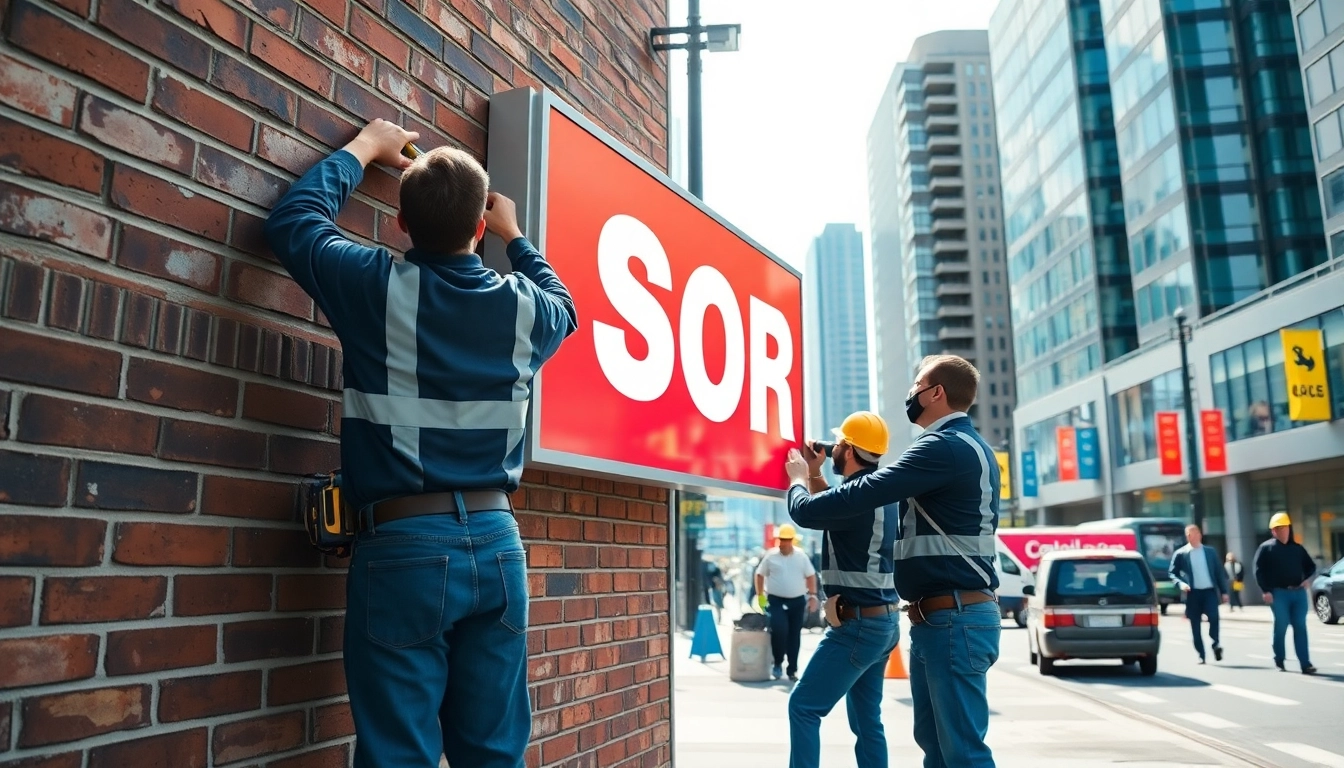Understanding Sign Installation Basics
Types of Signage and Their Applications
Signage is a powerful tool for communication and branding, playing critical roles in marketing and information dissemination. Understanding the various types of signage is essential for effective sign installation. Here are some of the primary categories:
- Digital Signage: Utilizes electronic displays to showcase dynamic content, ideal for businesses that wish to update their marketing messages frequently.
- Indoor Signage: This includes point-of-purchase displays, directional signs, and informational graphics within commercial spaces.
- Outdoor Signage: These signs are built to withstand environmental elements. They include billboards, storefront signs, and banners that promote visibility from a distance.
- Wayfinding Signage: Essential in large venues like malls and airports, these signs guide individuals to their destinations using arrows and landmarks.
- Temporary Signage: Often made of lightweight materials, these signs are used for short-term promotions or events.
- Safety and Regulatory Signs: These signs enforce compliance with safety regulations, providing essential information regarding hazards or legal requirements.
Each type of signage serves different purposes and requires specific installation techniques, demonstrating the importance of understanding your unique needs during the sign installation process.
Essential Tools and Equipment for Installation
The right tools are crucial for successful sign installation. Here’s a list of essential equipment:
- Drills and Drill Bits: For creating holes in various materials.
- Screwdrivers and Wrenches: To fasten components securely.
- Ladders and Scaffolding: For accessing high installations safely.
- Measuring Tools: Such as tape measures and levels to ensure accurate positioning and alignment.
- Safety Gear: Helmets, gloves, and harnesses to protect against injuries during the installation process.
- Cleaning Supplies: To maintain a clean workspace and ensure all components are dirt-free before installation.
Mastering the use of these tools not only enhances the installation process but also minimizes risks, ensuring efficient and safe operations.
Safety Regulations in Sign Installation
Safety regulations are paramount in sign installation, dictated by local laws and industry standards. Here are key regulations to follow:
- OSHA Standards: The Occupational Safety and Health Administration sets forth guidelines to ensure worker safety on job sites, including fall protection and workplace hazards.
- Local Building Codes: These regulations govern the structural integrity of signs and their installation in public spaces, ensuring public safety.
- Electrical Safety Codes: For illuminated signs, compliance with the National Electrical Code is essential to prevent electrical hazards.
- Permits and Approvals: Most municipalities require permits for sign installation, ensuring that installations abide by zoning regulations.
Understanding and adhering to these regulations reduces liability and enhances the longevity of your signage.
Planning Your Sign Installation Project
Assessing Location and Visibility Factors
Choosing the right location for your sign is crucial for maximizing visibility and impact. Consider the following factors:
- Traffic Patterns: Analyze the flow of pedestrian and vehicular traffic. High-traffic areas usually ensure better exposure.
- Viewing Distance: Ensure that your sign is readable from various distances. Depending on the type of signage, this could range from a few feet to several hundred feet.
- Surrounding Environment: Think about elements like trees, buildings, and other obstructions that might hinder visibility.
- Luminosity: Evaluate how lighting affects visibility. Well-lit areas may require illuminated signs, particularly for evening visibility.
- Local Community Standards: Understanding community aesthetics can guide designs that blend in or stand out appropriately.
Performing a thorough assessment of these factors aids in optimizing your installation strategy for better results.
Permitting and Legal Considerations
Before moving forward with your installation project, it’s essential to navigate the legal landscape associated with signage.
- Understanding Local Regulations: Engage with local planning departments to ensure compliance with restrictions and requirements specific to your zone.
- Application for Permits: Prepare detailed plans showing dimensions, materials, and design to submit for review.
- HOA Rules: If you’re in a governed community, ensuring that your signage complies with HOA rules is crucial to avoid fines.
- Insurance and Liability: Verify that you have proper insurance coverage in case of accidents or liabilities during installation.
Familiarity with these considerations can save you time, effort, and potential legal troubles in the future.
Budgeting for Your Sign Installation
A well-planned budget is imperative for a successful sign installation project. Here’s how to create a comprehensive budget:
- Define Costs: Divide costs into categories: design, materials, permits, labor, and maintenance.
- Get Multiple Quotes: Contact multiple vendors for estimates on materials and contractor services to ensure competitive pricing.
- Contingency Fund: Set aside a percentage of your budget for unexpected expenses that may arise during installation.
- Long-Term Considerations: Factor in future maintenance and potential upgrades or changes that might arise.
Creating a detailed budget can lay a strong foundation for your sign installation project, preventing financial strain down the line.
Step-by-Step Guide to Sign Installation
Pre-Installation Checklist
Before any installation work begins, a pre-installation checklist is vital to ensure everything is ready:
- Plans and Designs: Confirm that all sign designs meet specifications and have been approved by necessary authorities.
- Tool Inventory: Double-check that all tools and equipment are available and in working condition.
- Material Inventory: Ensure that you have all required materials and that they meet quality standards.
- Site Safety Check: Conduct a walk-through of the installation area to identify potential hazards.
- Staff Briefing: Communicate the installation plan clearly among the team members involved.
Addressing each item in this checklist can make a substantial difference in the flow of the installation process.
Executing the Installation Process
When it comes time to install the sign, consider the following steps:
- Site Preparation: Clear the area of any debris, ensuring a clean working environment.
- Marking Locations: Use measuring tools to identify and mark the exact spot where the sign will be installed.
- Base Installation: If necessary, secure the base using appropriate methods based on the materials (concrete, asphalt, etc.).
- Attach Sign Components: Securely mount the sign onto the previously installed base, ensuring it is aligned and level.
- Electrical Work: For illuminated signs, follow proper electrical codes to connect power sources safely.
Adhering to these steps will ensure that your sign is installed safely and securely, ready for use.
Post-Installation Quality Checks
After installation, conducting quality checks is essential to maintain the integrity and effectiveness of the sign:
- Visual Inspection: Check for alignment, leveling, and overall appearance. Ensure the sign meets design specifications.
- Functionality Tests: For illuminated signs, test lights and electrical components to ensure everything works as intended.
- Feedback Gathering: Solicit feedback from passersby or stakeholders to assess the sign’s clarity and visibility.
- Documenting Process: Take photographs and maintain records of the installation process for future reference.
These checks can help identify issues early and ensure that the installation was successful and meets the initial objectives.
Best Practices for Effective Sign Installation
Positioning and Height Considerations
The position and height of your sign can significantly influence its visibility and effectiveness. Consider these factors:
- Eye Level Placement: Install your sign at a height that draws attention, generally between 5 and 7 feet for pedestrian traffic.
- Angle of View: Consider the angles from which the sign will be viewed. Install signs at angles that optimize viewing for drivers and pedestrians alike.
- Elevation Change: If the terrain changes, adjust the height to maintain visibility regardless of the viewer’s elevation.
Utilizing these practices ensures your sign is easily discoverable to your target audience.
Illumination Techniques for Night Visibility
For signs used in low-light conditions, proper illumination techniques can enhance visibility significantly:
- LED Fixtures: LED lights are energy-efficient and long-lasting, making them ideal for illuminating signs.
- Spotlighting: Directing focused beams at the sign can create impact, especially for larger signs.
- Backlighting: This technique involves placing lights behind the sign to create a halo effect, enhancing visibility at night.
- Adjustable Lighting: Installing dimmable systems allows you to adapt the brightness according to different times of day.
Choosing the right illumination technique can make your sign stand out in all lighting conditions, increasing engagement.
Maintaining and Repairing Signs Long-Term
Maintenance is key to ensuring the longevity and effectiveness of your signage. Here are best practices for upkeep:
- Regular Inspections: Schedule routine inspections to check for wear and tear, fading, or any damage.
- Cleaning: Keep signs clean from dirt, debris, and grime that can obscure messages and reduce attractiveness.
- Prompt Repairs: Address any issues immediately to prevent further deterioration. Replace bulbs, repaint, or repair structural damage as needed.
- Document Maintenance Work: Maintaining records of inspections and repairs can be beneficial for warranty claims or budgeting future costs.
Implementing these maintenance practices prolongs the life of your signs and maintains their visibility and effectiveness over time.
Measuring Success After Sign Installation
Tracking Visibility and Engagement Metrics
Understanding the impact of your signage requires data. Focus on the following metrics:
- Foot Traffic Counts: Use counters to measure the number of visitors before and after installation.
- Sales Correlation: Analyze sales data to see if there’s an increase linked to the signage update.
- Social Media Mentions: Track social media buzz regarding your business after sign installation as a measure of brand visibility.
- Time Spent in Area: Observe behavioral changes, such as how long people linger in areas where signage is present.
Establishing a metrics-driven approach allows businesses to gauge the effectiveness of their sign installations accurately.
Gathering Customer Feedback on Signage
Direct feedback from customers provides valuable insight into the effectiveness of your signage:
- Surveys and Polls: Conduct surveys to collect opinions on sign clarity and helping customers navigate your venue.
- Focus Groups: Engage small groups of customers to understand their thoughts about the signage.
- In-Store Feedback: Encourage customers to share their experiences regarding signage and wayfinding as they navigate your space.
Utilizing customer feedback can inform future updates and help refine your signage needs.
Adjusting Strategies Based on Performance Data
Using the data collected, businesses can make informed adjustments to improve their signage strategy:
- Revise Sign Designs: If certain designs attract less engagement, consider testing new styles or messaging.
- Change Locations: Adjust the positioning of signs that aren’t performing well to new, strategic locations.
- Time for Further Investment: If a particular format performs well, consider expanding or investing more heavily in that area with additional signage.
Continually refining and adapting strategies based on performance data ensures that signage remains relevant, engaging, and effective over the long term.



